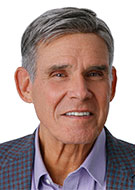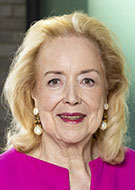Radiology in public focus
Press releases were sent to the medical news media for the following articles appearing in recent issues of RSNA Journals.

Researchers Advocate for Separate Roles Between AI and Humans
Renowned physician-scientist Eric J. Topol, MD, and Harvard AI expert Pranav Rajpurkar, PhD, advocate for a clear separation of the roles between AI systems and radiologists in an editorial published in Radiology.
“We’re stuck between distrust and dependence, and missing out on the full potential of AI,” said Dr. Rajpurkar, associate professor of Biomedical Informatics at Harvard University in Cambridge, MA.
The authors call for redefining AI’s assistive role, noting that full integration into radiology workflows has not met expectations.
“It’s still early for getting a definitive assessment,” said Dr. Topol, professor and executive vice president, Scripps Research. “But several recent studies of GenAI have not demonstrated the widely anticipated synergy between AI and physicians.”
The authors proposed a framework with the goal of providing a practical roadmap for AI integration grounded in evidence and flexibility.
Read the related RSNA News story.

Emphysema at CT Lung Screening Increases Death Risk in Asymptomatic Adults
A Radiology study found that emphysema identified on baseline low-dose chest CT (LDCT) in the lung cancer screening cohort of more than 9,000 asymptomatic adults was linked to an increased risk of death from all causes, chronic obstructive pulmonary disease (COPD) and cardiovascular disease, over a 25-year follow-up period.
“Until now, we didn’t know if baseline visual emphysema scoring on LDCT in the lung cancer screening setting had any prognostic value,” said Claudia I. Henschke, PhD, MD, professor of radiology at the Icahn School of Medicine at Mount Sinai in New York.
The study followed 9,047 adults enrolled in the International Early Lung Cancer Action Program for up to 25 years. Emphysema was identified in nearly 30% of participants, most of whom had not been previously diagnosed. Mortality risk rose with emphysema severity, with severe cases linked to more than double the risk of death from all causes and a 12-fold increase in COPD mortality.
Read the related RSNA News story.

RSNA AI Challenge Models Can Independently Interpret Mammograms
In a Radiology study led by Yan Chen, PhD, of the University of Nottingham in England, algorithms from the 2023 RSNA AI Challenge—entered by more than 1,500 global teams—showed high accuracy for detecting breast cancers on mammography, improving sensitivity while maintaining low recall rates.
“We were overwhelmed by the volume of contestants and the number of AI algorithms that were submitted as part of the Challenge,” Prof. Chen said. “It’s one of the most participated-in RSNA AI Challenges. We were also impressed by the performance of the algorithms given the relatively short window allowed for algorithm development and the requirement to source training data from open-sourced locations.”
The top 10 algorithms achieved a combined sensitivity of nearly 68%, approaching the accuracy of an average screening radiologist. Many of the models are open source, providing valuable data for continued research and benchmarking.
Read the related RSNA News story.

RSNA in the News
Through proactive outreach to global media, RSNA’s media relations program showcases groundbreaking research and cutting-edge discoveries. The program strengthens awareness of both the specialty and the Society’s leadership in driving innovation in medical imaging.
In August, 1,397 RSNA-related news stories were tracked in the media. These stories had over 1.2 billion audience impressions.
Coverage included Healio, Forbes, Becker’s Hospital Review, Benzinga, MedPage Today, Medscape, AuntMinnie.com, Applied Radiology, Health Management and Healthcare Business News.
Help Your Patients Understand their Radiology Reports
RadiologyInfo.org offers an expanding series of resources to help radiologists provide patients with the information they need to make educated decisions about their care.
Our "How to Read Your Radiology Report" series consists of articles and videos to help explain the complex language, findings and impressions often seen in imaging reports.
Topics currently include abdominal and pelvic CT, MR cholangiopancreatography, lung cancer screening, liver imaging and pelvic imaging, with new articles added regularly.
Explore and share the “Reading Your Radiology Report” section with your patients today.